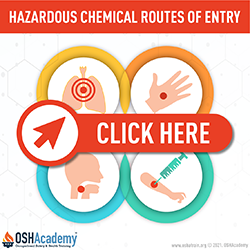Routes of Entry
Another important task when assessing the workplace for chemical hazards is to determine the route(s) of entry the chemicals may take. If we know the route(s) of entry, we can then determine appropriate engineering, administrative, and PPE controls to eliminate or reduce the exposure. The four common routes of entry are:
- Inhalation
- Breathing in chemical vapors, gases, dust, or fumes
- The most common route of exposure, particularly for volatile substances
- Ingestion
- Swallowing chemicals, either accidentally or through contaminated food and drink
- Less common in workplace settings but can occur through poor hygiene practices
- Absorption
- Entry of chemicals through the skin
- Can occur through direct contact with chemical substances or contaminated surfaces
- Injection
- Entry of chemicals through punctures or cuts in the skin
- May be accidental or intentional needlesticks or cuts by sharp objects
Knowledge Check Choose the best answer for the question.
2-4. What is the most common route of entry of a hazardous chemical?
You forgot to answer the question!

